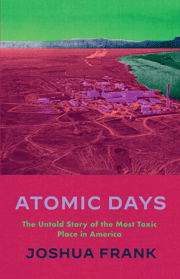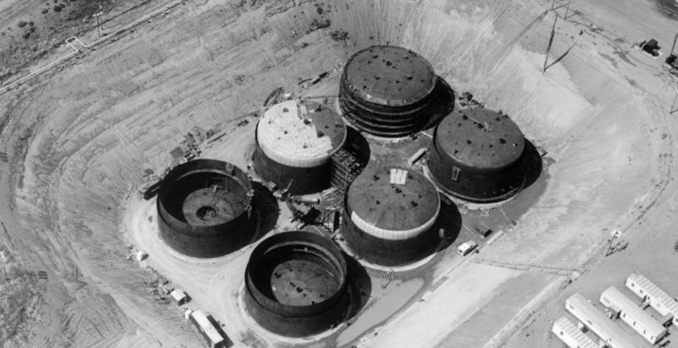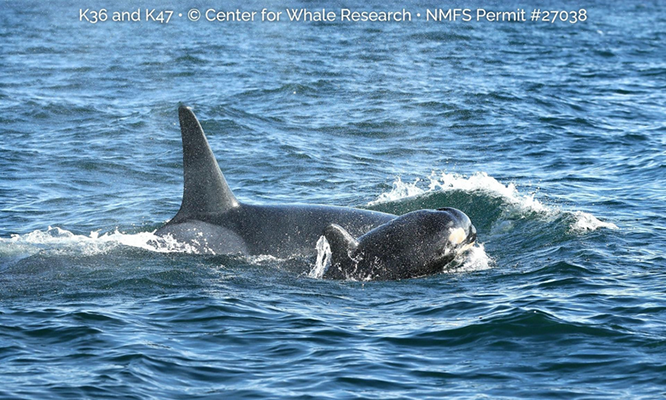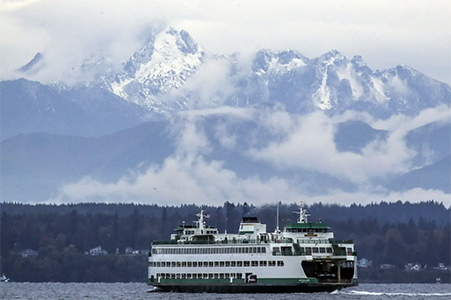||| FROM COUNTERPUNCH.ORG |||
Last week, the Department of Energy, which oversees the aging nuclear site in Hanford, Washington, reported that a tank containing high-level radioactive waste was leaking. This is currently the third tank we know of that’s releasing deadly nuclear waste into the soil above the groundwater that feeds the nearby Columbia River. This is not a new problem for Hanford, which has 177 of these huge underground tanks that contain 55 million gallons of radioactive leftovers from the US’s nuclear weapons operation. These waste tanks were only supposed to hold up twenty to thirty years, and we’re now going on well over six decades. Below is an excerpt from my book Atomic Days, which details the site’s sordid history and its extremely problematic future. Sadly, leaks at Hanford are nothing new, nor are the lies surrounding them. It’s a looming nuclear danger that’s bubbling in our own backyard, and I’m scared. You should be, too. – Joshua Frank
+++
The first sign of legitimate danger at Hanford, at least when it came to the US public’s attention, occurred in June 1973, when a massive storage unit called 106-T at the complex’s tank farm was confirmed to have leaked 115,000 gallons of boiling radioactive goop into the sandy soil surrounding its underground hull. An investigation by the contractor Atlantic Richfield tried to calm nerves by asserting the atomically charged liquid did not make it into the groundwater supply. “It was predicted that the leaked waste would be retained by the dry sediment above the water table,” the report stated. “The greatest depth to which this liquid waste penetrated is about twenty-five meters below the ground surface, or about thirty-seven meters above the water table.” While the science indicated the contaminants did not leak into the groundwater or into the nearby Columbia River, the incident showed that another such accident, and one of an even greater magnitude, could happen at one of Hanford’s other storage tanks.
What was perhaps most alarming about the 1973 event was that not a single person could say exactly how long 106-T had been leaking or what had caused the tank to crack in the first place. In fact, when administrators eventually realized what was going on, they weren’t even sure what was inside 106-T. There was no panic. No major alert to workers, and not even a pithy press release warning the community about what administrators did or did not know. The secretive culture at Hanford was still alive and flourishing.
Workers had first noticed the problem on a Friday, June 8, 1973. But it wasn’t until Saturday, June 9, that administrators began thumbing through their reports and read-outs in an attempt to uncover what was actually missing from 106-T. Even though pages and entire sections were nowhere to be found, the investigating team was able to piece together what they believed had occurred. For a full fifty-one days, an average of 2,100 gallons of gunk had seeped out of 106-T every twenty-four hours.
In total, 151,000 gallons emptied into the soil, which included forty thousand curies of cesium-137, four curies of plutonium, fourteen curies of strontium-90 and other, slightly less toxic sludge. There had also been numerous leaks at Hanford in the early years. In 1958, fifteen different tanks leaked some 422,000 gallons of a similar nuclear waste by-product. Yet the 106-T was an entirely different animal. The 1973 accident was the largest single radioactive waste disaster in the history of Hanford, if not the United States, and unlike the incidents recorded in 1958, newspapers were finally covering it.
Mounting public concern
The Atomic Energy Commission (AEC), which oversaw operations in 1973, came under scrutiny in the press for the alleged mismanagement of Hanford’s tank farm. “The scope of the problem is staggering,” read a Los Angeles Times investigative piece. “It has been estimated, for example, that there is more radioactivity stored at the single Washington (Hanford) reservation than would be released during an entire nuclear war.”
The 106-T disaster also impacted public perception of the safety of the United States’ nuclear technology. AEC commissioner Clarence E. Larson tried to downplay the accident and his agency’s role in the mess, as well as the “implications that large masses of people are endangered.” Larson, and a governmental report that followed, laid much of the blame on the contractor Atlantic Richfield and a few bad apples inside the AEC.
**If you are reading theOrcasonian for free, thank your fellow islanders. If you would like to support theOrcasonian CLICK HERE to set your modestly-priced, voluntary subscription. Otherwise, no worries; we’re happy to share with you.**









From Atomic Days (Joshua Frank)–
“Once home to the United States’ largest plutonium production site, the Hanford Nuclear Reservation in Washington state is laced with 56 million gallons of radioactive waste. The threat of an explosive accident at Hanford is all too real—an event that could be more catastrophic than Chernobyl.”
“The EPA designated Hanford the most toxic place in America; it is also the most expensive environmental clean-up job the world has ever seen, with a $677 billion price tag that keeps growing. Huge underground tanks, well past their life expectancy and full of boiling radioactive gunk, are leaking, infecting groundwater supplies and threatening the Columbia River.”
“Whistleblowers, worried that the worst is ahead, are now speaking out, begging to be heard and hoping their pleas help bring attention to the dire situation at Hanford. Aside from a few feisty community groups and a handful of Indigenous activists, there is very little public scrutiny of the clean-up process, which is managed by the Department of Energy and carried out by contractors with shoddy track records, like Bechtel. In the context of renewed support for atomic power as a means of combating climate change, Atomic Days provides a much-needed refutation of the myths of nuclear technology—from weapons to electricity—and shines a spotlight on the ravages of Hanford and its threat to communities, workers and the global environment.”
In principle, nuclear energy is a wonderful thing. The proponents give it the appearance of an industry that produces massive amounts of clean energy at a low cost to consumers, while at the same time one that uses the resultant waste to build nuclear weapons as a deterrent safeguarding the world from war. A win-win situation right? Wrong. It’s the exact opposite. Once you see it you can’t unsee it.
Reality check– from its very inception, the production of nuclear energy has always represented the highest levels of government and corporate collusion. It is corporate capitalism at its worst. It’s a tax subsidized industry from beginning to end that produces dirty energy with massive economic and social costs to the taxpayers that fund it, alongside massive profits to the corporations and weapons manufacturers that promote it, resulting in a high-probability of the worst-case-scenario (nuclear conflict). The true winners are the company shareholders, (think your elected officials), and the lobbyists and companies they represent (both from the civilian sector, and the defense industry alike), that reap profits from it.
The lack of oversight and accountability offered by the former Atomic Energy Commission and the Nuclear Regulatory Commission, (the very governmental agencies commissioned by congress to protect us), has proven their complicity in the coverup and scandal that’s being perpetrated on the people. The proponents of nuclear energy have, over time, lobbied our congressional leaders to put in place preemptive legislation labeling nuclear power as a clean, carbon free source of energy, and are now promoting it as a green energy that will save humanity from its dependence on fossil fuels… this representing government coverup and corruption at the highest levels. You can bet that our congressional leaders all own stock in the companies that produce and promote it. Once you see it you can’t unsee it.
From It’s OK To Be Angry About Capitalism (Bernie Sanders)— “In this unprecedented moment in American history, there is no more time for tinkering around the edges. It is time to reject “conventional wisdom” and “incrementalism.” It is time to fundamentally rethink our adherence to the system of unfettered capitalism, and to address the unspeakable harm that system is doing to us all. The simple truth is that unfettered capitalism is not just creating economic misery for the majority of Americans, it is destroying our health, our well-being, our democracy, and our planet. If we hope to save ourselves, we must identify the people and the policies that engineer this destruction. The fight against American oligarchy- and the plutocratic arrangements that foster it- has nothing to do with personalities. Inequality isn’t about individuals; this is a systemic crisis.”
I often think about when this Ponzi scheme of a “global economy” collapses, who will be making sure the nuclear waste at nuclear power plants and sites like Hanford is safe? No one, that’s who.
(And in case you’re doubting whether it will collapse, there are two scenarios. The global economy, built on debt and requiring infinite growth so as to not collapse, is entirely dependent on fossil fuels, this should be obvious to everyone reading this. So, either 1) we keep burning fossil fuels and other destructive ways of generating electricity and energy to keep the economy afloat and habitat loss, pollution, and climate change come for us and the economy collapses anyway. Or 2) we stop burning fossil fuels and stop other destructive ways of generating electricity and energy so as to reduce habitat loss, pollution, and climate change and the economy collapses. No matter what, the economy will collapse. And then there will be no money and few who care to volunteer to spend every day working to make sure the nuclear waste is safe. And then soon, it won’t be safe, and… someone should make a movie!! It would make a great story, except there will be no one left around to watch it.)
Chernobyl, despite the horrific toll it took on people (and is still taking as the radioactive particles still encircle the Earth), has turned into a wildlife refuge of sorts. Yes, a nuclear disaster was less destructive than industrial civilization! Amazing.
Everybody loves the bubble… everybody’s on the gravy train. Everybody’s making money while they’re setting up the perfect storm.